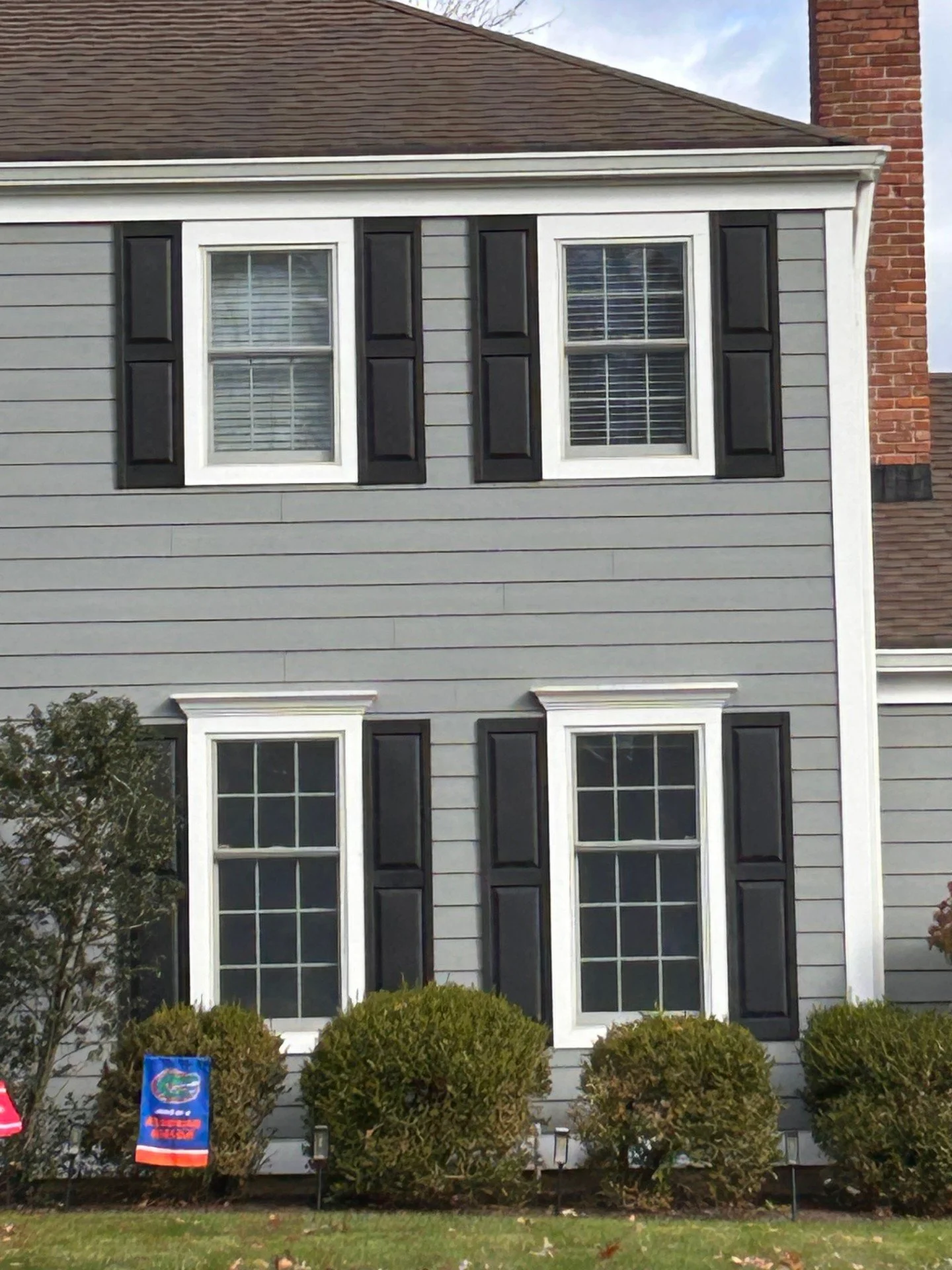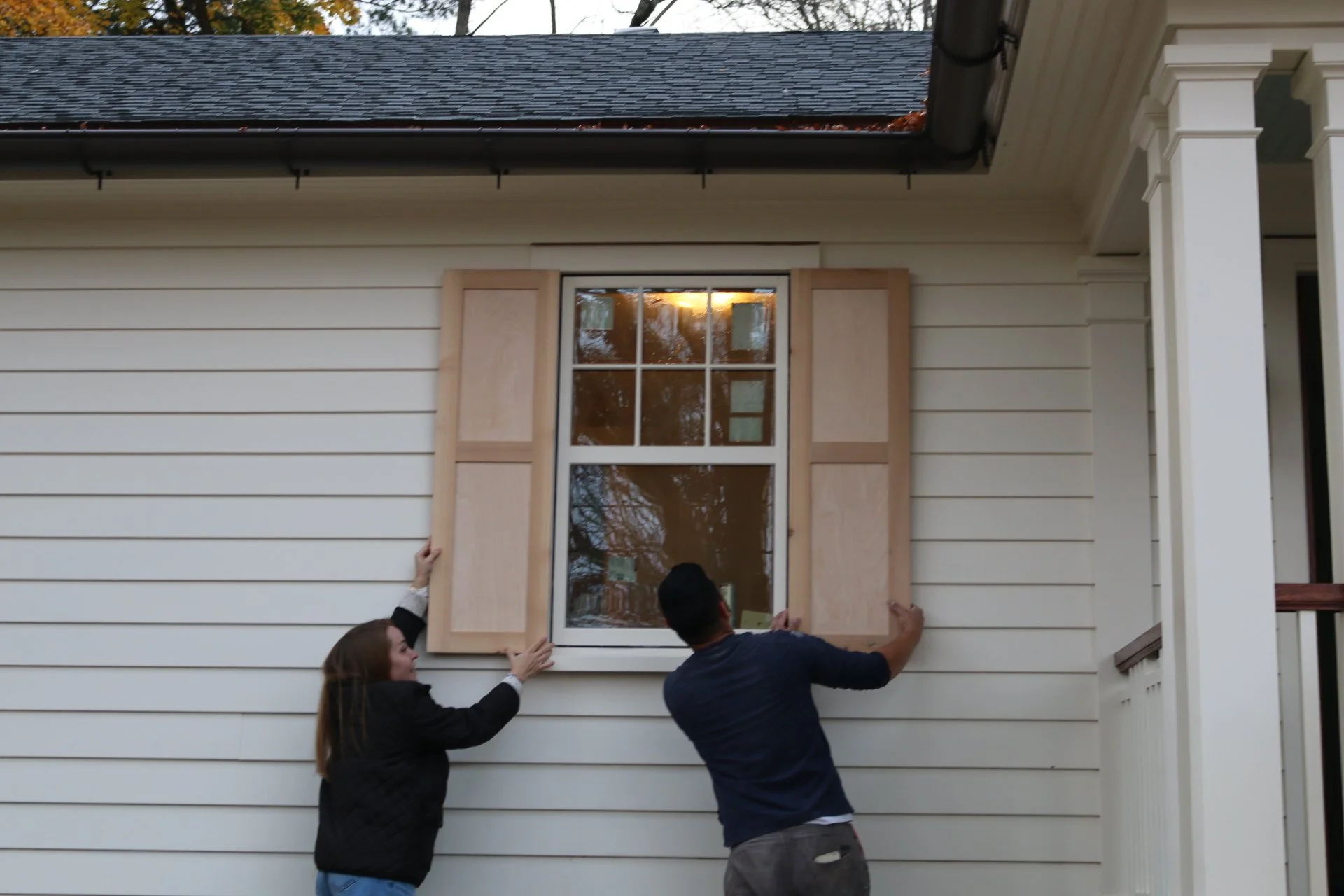In an age of rapid construction and mass-produced building components, it’s easy for homes to lose the timeless qualities that once defined well-crafted architecture. Yet authentic architectural details—those elements that are not just decorative but rooted in purpose—remain essential to creating beautiful, lasting, and contextually appropriate homes.
At Clawson Architects, we believe that thoughtful attention to these details is not merely an aesthetic preference but a responsibility. Authenticity in design preserves architectural traditions, strengthens neighborhood character, and elevates the daily experience of the people who live within these spaces.
Custom Shutters — all different sizes created to protect the windows they serve.
One of the best handbooks on this subject is Get Your House Right by Marianne Cusato, which champions a return to classical principles, proportion, and meaningful details. It serves as a reminder that when architects and builders understand the origin and function of an architectural element, the result is a home that feels right—balanced, enduring, and human.
Function First: The True Purpose of Architectural Details
Architectural details originated to serve specific functions—structural, climatic, or practical. Over time, many of these elements became decorative as technology evolved. But when we detach a detail from its purpose entirely, it stops being architecture and becomes ornament for ornament’s sake.
This is where so many contemporary homes falter. Manufacturers sell “architectural features” that are often superficial versions of once-functional components. Applied incorrectly, they distort proportions, confuse architectural language, and create visual noise rather than harmony.
There is perhaps no better example of this than the modern misuse of window shutters.
The Shutter: A Case Study in Purpose vs. Pretense
Architect is N O T H A P P Y…WHY? The contractor and his assistant were showing the architect from Clawson Architects the shutter that they built…why the disappointed face ???? because the cross rail on the shutter does not line up with the check rail on the window. First clue that this was not the right shutter for this window.
As Cusato explains, shutters were originally designed as functional, operable panels used to protect windows, provide privacy, and regulate light and ventilation—especially before the widespread use of glass and climate control.
True, functional shutters:
Are sized to fully cover the window when closed
Are mounted on hinges
Have a thickness and profile appropriate to their style
Appear visually capable of swinging shut
Align with the window’s vertical stiles and horizontal rails
When shutters are designed and installed with these principles, they contribute to both the visual balance of a façade and its architectural integrity.
And then there are the fake ones.
The shutters are on pins and have shutter cocks to hold them in the wind …but, they are the wrong size and the pins are installed in the wrong location. The shutters on the lower windows would only cover the casing and one 1/3 of the first window. The “picture framing below the window is also a bad detail. Window sills are an important functional detail. They are designed to assist in shedding rain water away from the home to reduce rot and deterioration.
When Shutters Become a Travesty
You can see them everywhere: thin plastic panels screwed directly onto siding, too small to ever cover the window behind them, and placed so far from the window frame they could never function—even hypothetically.
These “surface-applied” shutters violate the most basic rules of architectural honesty.
Why is this such a problem?
1. They undermine proportion and scale.
A pair of shutters that are clearly too narrow or too short or too long, disrupts the visual geometry of the window. Rather than framing the opening, they call attention to the fact that they don’t fit.
Shutter placement wrong. Size Too long. Not functional just “stapled on”
2. They signal inauthenticity.
Again, the shutter placement is not correct….and what is going on with the ones on the bottom?
Architecture tells a story. Fake shutters tell the wrong one. When a detail contradicts its original function, it weakens the building’s credibility and confuses its style.
3. They diminish curb appeal rather than enhance it.
A home with thoughtfully designed, operable shutters looks elegant and intentional. A home with plastic, screw-on panels looks cluttered and unresolved.
Applied instead of functional, Check rail does not align with the cross rail on the shutter. Shutters too long…they should be size of the window. Picture framed windows on exterior are a maintenance nightmare and never a good idea as they do not encourage water to shed away from the home….The lack of a sill also removes the shadow line and the facade looks flat.
4. They miss an opportunity for craftsmanship.
Well-made shutters—properly sized, hinged, and styled—add depth, shadow, texture, and character. Faux shutters flatten the façade.
Authenticity Elevates Architecture
Great architecture is not just about appearance—it’s about integrity. The way a building is put together should make sense both visually and functionally. This is why books like Get Your House Right emphasize returning to the logic of traditional architecture: when proportions and details follow their historical purpose, beauty naturally follows.
She’s H A P P Y N O W!!! The Architect is assisting and guiding the team on the placement. Note the cross rail on the shutter aligns with the check rail. The shutters are inside the casing and above the sill. They will be placed on pins so the rotate and there will be shutter cocks to hold them in place.
At Clawson Architects, we incorporate authentic details not because we are beholden to tradition, but because we are committed to quality, meaning, and place-making. When every element has a clear role, architecture becomes harmonious, timeless, and deeply satisfying.
The shutters are in scale with the window size. They are functional and would cover the window if closed. Note that the authentic shutters and window sills give shadow and depth to the facade.
Conclusion: Details Matter Because People Matter
Authentic architectural details aren’t about nostalgia. They’re about respecting the craft and caring for the people who will live with the architecture long after the plans are filed away.
Shutters are just one example of how honoring the true purpose of an element can transform a façade from forgettable to enduringly beautiful. When we design with intention, understanding, and honesty, we create homes that feel right—not just today, but for generations. If you are looking to “Get your house right” … Clawson Architects is a full service architectural firm that will stay with you to the end to make certain that the carefully detailed drawings they create for your home are realized. Give us a call.









